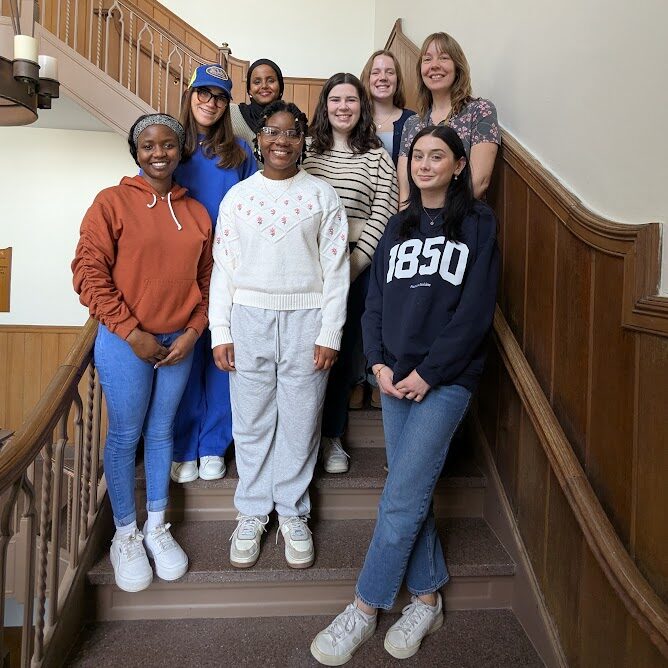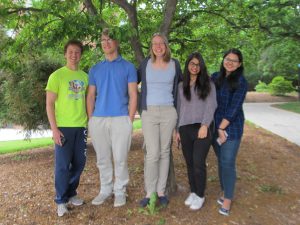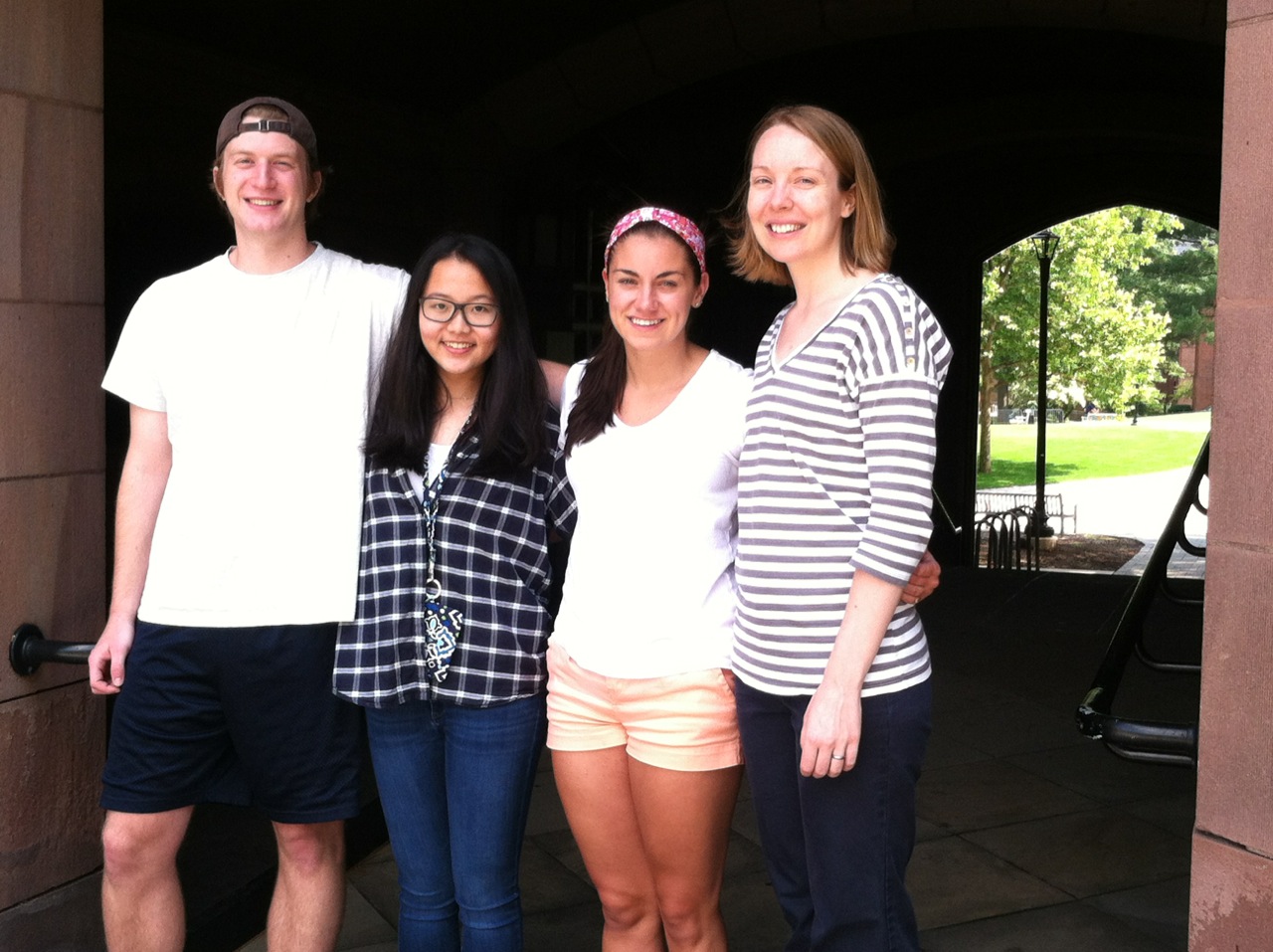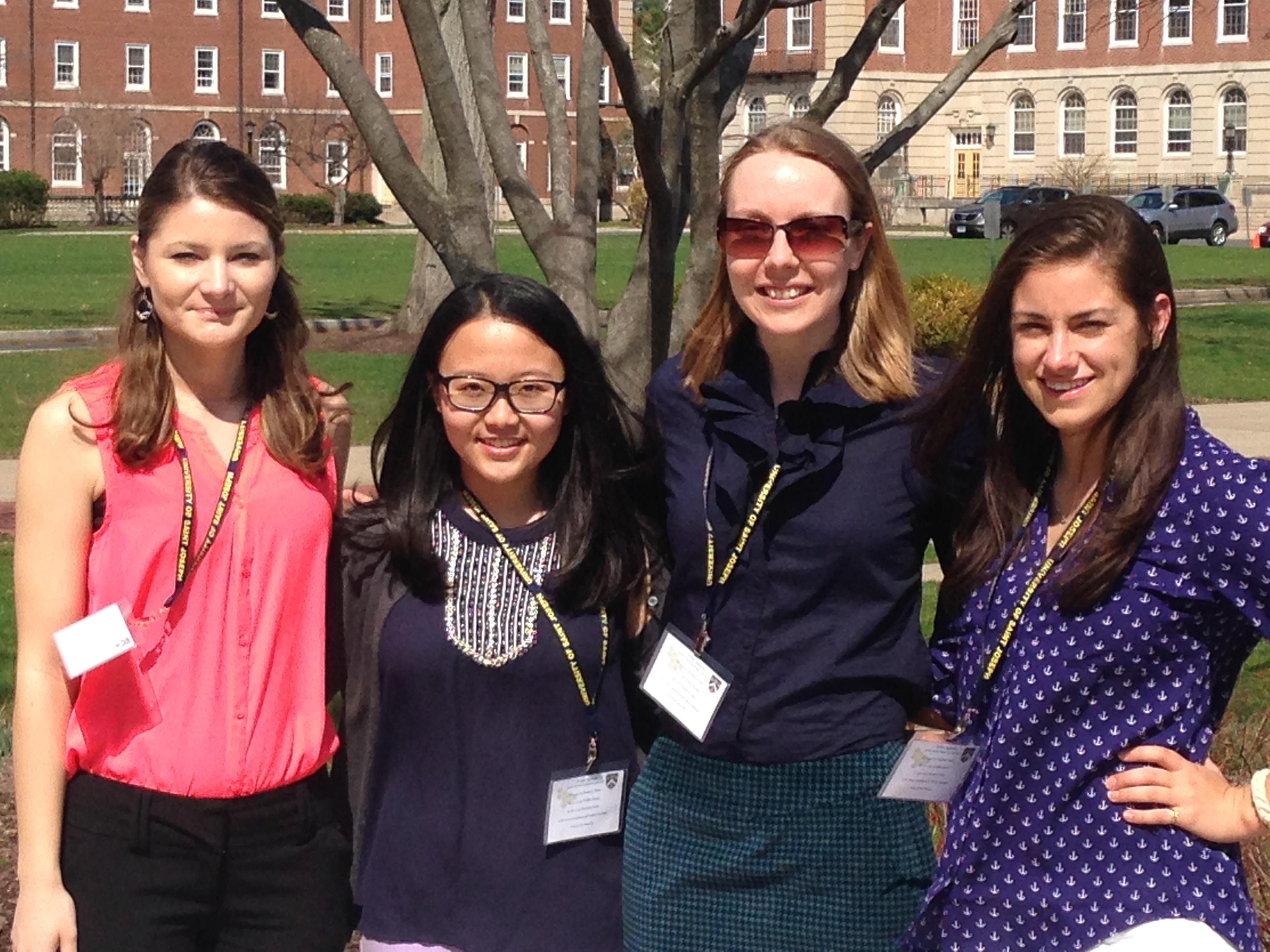Current Students
Jackson Moore (2025) is using a peptide substrate reporter to characterize an unknown PBK homolog in Tetrahymena thermophila.
Izzy Baratta (2025) started in the lab by investigating the role of reactive oxygen species in cell signaling during Dictyostelium discoideum social development. Currently, she is exploring the use of DART-MS for metabolomics in D. discoideum.
Naiya Newhouse (2024-25) started in the lab as a Project SEED summer student and is developing methods to apply photo-activated caged peptides for kinase assays in Dictyostelium discoideum.
Frances Huff (2023-25) is developing assays to study metal stress response in Tetrahymena thermophila using fluorescence microscopy, flow cytometry, and ICP-MS.

Former Lab Members
Jaysean Johnson (2025) was a summer student through Project SEED working with Sharon Sango on separations-based methods for multiplexed ROS detection.
Asia Hamilton (2023-25) started in the lab as a summer student through Project SEED and designed microfluidic chips for single-cell analysis of Tetrahymena thermophila. She continued her research by designing devices to study electrotaxis.
Margaret Spuler (2025) worked with Frances Huff on multi-model measurements of metal stress response in Tetrahymena thermophila.
Alexandra Curbelo (2024-25) integrated fiber optics into the detection system for our single-cell microfluidic device. She is now studying optometry in Chicago, IL.
Sharon Sango (2022-25) optimized electrophoretic separations of reactive oxygen species indicators for multiplexed measurements of oxidative stress.
Andres Rodriguez (2022-24) worked on multiplexed measurements of reactive oxygen species in cells.
Emma Murphy (2024) did her ISP research internship working on simultaneous determination of superoxide and nitric oxide in D. discoideum during social development.
Dhanushka Weerasekara, PhD. (2023-24) was a visiting scientist in the lab, working on ICP-MS of cell lysates and stimulation of cells prior to chemical cytometry on-chip.

Sarah Hogan (2023-24) worked in the lab through the Advanced Research Mentorship (ARM) program at Glastonbury High School. She developed metal-adapted strains of Tetrahymena thermophila using chronic metal exposure.
Caina Pierre (2023-24) used electroporation and DMNB-caging to load peptide substrate reporters for PKB into Dictyostelium discoideum. She is currently working as a medical scribe.
Karina Amador (2022-23) established on-chip pumping conditions to expose cells to chemical stimuli before lysis. She is currently a Child Advocate at the YWCA.
Tyler Allcroft (2020-2023) performed single-cell studies of Dictyostelium oxidative stress response to singlet oxygen produced by Rose Bengal and blue light. For his senior thesis, he studied the role of cell cycle in heterogeneity of stress response in this system. He is currently a student at the Sidney Kimmel Medical College at Thomas Jefferson University.

Shanya Thomas (2022) was an ACS Project SEED participant who worked in the lab with Sharon Sango on antimycin A-induced production of superoxide before she started her undergraduate career at the University of Connecticut.
Samiya Mehammed (2022) collaborated with Karina Amador on a project to establish on-chip pumping conditions so that we can expose cells to chemical stimuli before lysis.
Cameron Esler (2022) did his ISP research in the lab on electroporation for peptide loading in Dictyostelium.
Mengqi (Jonathan) Fan (2019-2021) optimized microchip electrophoresis separations of peptide substrate reporters for protein kinase B and studied the effect of lipid bilayer coating charge on cell adhesion in microchips. He went on to study protein kinase B activity in lysates using peptide substrate reporters and Western blotting. He is currently a doctoral student in chemistry in the Kelley Lab at Northwestern University.

Will Krohg (2020-2021) helped to develop separation conditions for capillary electrophoresis of mixtures of reactive oxygen species indicators and peptide substrate reporters.
Misha Mehra (2018-2021) used physiological and pharmacological interventions to study the specificity of several peptide substrate reporters for protein kinase B in Dictyostelium lysates.
Alice Martynova (2019) did summer research with Prof. Cheyenne Brindle and me to attempt the synthesis of a fluorogenic superoxide indicator. She is currently a doctoral student in chemistry in the Bush Lab at the University of Washington.
Daniel Feldman (2019) worked with our collaborator, Prof. Guardiola-Diaz in Trinity’s Department of Biology, to develop a peptide substrate reporter for mTOR.

Jason Deck (2018-2019) adapted a MatLab program to automate data analysis of our single-cell electropherograms. He also studied the effect of glucose and rotenone on oxidative stress in Dictyostelium as measured by several indicators. Jason recently graduated from the University of Connecticut School of Dentistry.
Sababa Anber (2018-2019) is doing enzyme assays to determine the Michaelis-Menten kinetics of several peptide substrates for serine-threonine kinases with the human and Dictyostelium forms of protein kinase B. She is worked as research technician at Columbia University before starting medical school at the Duke-NUS Medical School.
Rahuljeet (RJ) Chadha (2017-2019) characterized how peptide loading by electroporation and myristoylation influences the metabolism of a peptide substrate reporter in intact Dictyostelium cells. In 2018, he began looking at the specificity of several peptide substrate reporters in Dictyostelium lysates using mutant strains. RJ is currently in the doctoral program in chemistry in the Wei Lab at Caltech.
Jessica Duong (2015-2019) started in the lab by exploring the (non!)compatibility of supported bilayer membranes and surfactants used in micellar electrokinetic chromatography (MEKC) on hybrid PDMS-glass microchips. She went on to do chemical cytometry experiments on the heterogeneity of oxidative stress response in Dictyostelium cells treated with hydrogen peroxide and Rose Bengal. She was a WW Teaching Fellow at the University of Pennsylvania and now teaches high school science.
Greg Kalminskii (2017-2018) optimized and characterized pinocytic loading methods for introducing peptide substrate reporters into Dictyostelium. In 2018, he began a collaboration with Prof. Guardiola-Diaz in Trinity’s Department of Biology to look at mTOR activity in oligodendrocytes. He went on to complete his undergraduate degree at Swarthmore College.
Julia Clapis (2016-2018) researched the role of supported lipid membrane coating composition on their function in microfluidic devices. In 2016-2017, she extracted and purified lipids directly from eggs to explore how the purity of the lipids affects the coatings. In 2017-2018, she examined at the role of lipid coatings in minimizing cell adhesion. Julia went on to study at the University of Connecticut School of Dentistry.
Josh Knopf (2016-2017) optimized an electroporation method for loading peptide substrate reporters into Dictyostelium. He went on to medical school at the University of Connecticut.

Kathy Rodogiannis (2016-2017) wrote her senior thesis on chemical cytometry of Dictyostelium discoideum. Her focus was characterizing heterogeneity in reactive oxygen species in these cells. She worked as a Perfumery Technician at Givaudan before moving to Osmo.
Allie Tierney (2015-2017) led our research on capillary electrophoresis-based assays of peptide degradation in Dictyostelium lysates and in lysates from other cell types. She went on to explore how degradation of the peptide-based reporters differs in intact cells compared to lysates. She completed her Master’s degree in the Roper Lab at Florida State University before working at NanoTerra. She completed her doctoral degree in chemistry in the Mace Lab at Tufts University.
Kunwei Yang (2014-2016) developed capillary electrophoresis methods for phosphorylation assays of protein kinase B (PKB) in Dictyostelium lysates. This work combined research on PKB activity in Dictyostelium with a peptide reporter for PKB previously developed for use in human cells. She is currently a graduate student at Michigan State University.

Casey Crowley (2016) began our chemical cytometry experiments on Dictyostelium by optimizing dye loading and on-chip lysis procedures. She went on to complete her undergraduate degree in biomedical engineering at Case Western University.
Zachary Garber (2015) studied the effects of lipid bilayer composition and divalent metal cations on the stability of support bilayer membrane coatings in microchip electrophoresis. He worked as an analytical chemist at Aspen Research before continuing his research career at the University of Wisconsin.

Livia Shehaj (2013-2015) characterized supported bilayer membrane coatings in PDMS-glass hybrid microfluidics. She wrote a custom LabView program to record conductivity data for measurements of electroosmotic flow, which we are using as a readout for membrane stability. She also made LIF measurements of fluorescein and carboxyfluorescein to investigate the effects of natural vs. synthetic lipids and initiated studies on the effect of cholesterol content on coating stability. She obtained her Master’s degree working in the Kritzer Lab at Tufts University and is currently a Principal Research Associate at Accent Therapeutics.
Ellie Clerc (2014) helped to design and construct the microchip electrophoresis-laser induced fluorescence set-up for the lab at Trinity College. She wrote a LabView program for high voltage control, soldered together leads for electrophoresis, designed an adapter plate for our detector in SolidWorks, and fabricated chips for gated injections.
Berjana Nazarko (2014) followed up on Lorena Lazo de la Vega’s project, loading an exogeneous reporter peptide into Dictyostelium cells. She studied the effects of loading time and concentration for a myristoylated peptide and did preliminary experiments on Dicty development. She went on to the master’s program at Central Connecticut State University and a career in biotechnology.

Lorena Lazo de la Vega (2013-2014) wrote her senior thesis on methods to load a reporter peptide into Dictyostelium cells. This work involved her in cell culture, pinocytosis, electroporation, and fluorescence microscopy. She completed her PhD in pathology in the Tomlins Lab, worked as a Research Fellow at Brigham and Women’s Hospital, and is now a Scientist at the Dana Farber Cancer Institute.
